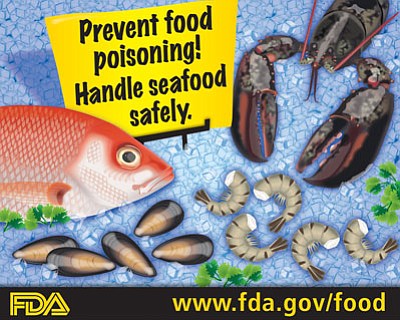Washington D.C — Silver Spring, Md.— October is National Seafood Month and a time to highlight the importance of fish and shellfish as part of a healthful diet. As with any food, safe handling of seafood is essential to reducing the risk of foodborne illness, often called food poisoning.
The U.S. Food and Drug Administration (FDA) is reminding the public to follow these basic safety tips for buying, storing, and preparing fish and shellfish.
Buy Right: Fresh Seafood— When buying fresh fish or shellfish, be sure that it is refrigerated or displayed on a thick bed of fresh ice that is not melting. Preferably, it should be displayed in a case or under some type of cover.
Check for these signs of freshness:
Fish:
*Fish should smell fresh and mild, not fishy, sour, or ammonia-like.
*A fish’s eyes should be clear and bulge a little.
*Whole fish and fillets should have firm, shiny flesh and bright red gills free from slime.
*The flesh should spring back when pressed.
*Fish fillets should display no discoloration nor darkening or drying around the edges.
Shellfish:
*Look for tags and labels on live shellfish (in the shell) and on containers or packages of shucked shellfish that
include a certification number for the processor. This means that the shellfish were harvested and processed in accordance with FDA national shellfish safety controls.
*Throw away any clams, oysters, and mussels with cracked or broken shells.
*Live clams, oysters, and mussels will close up when the shell is tapped. If they don’t close, do not select them.
*Live crabs and lobsters should show some leg movement. They spoil rapidly after death, so only live crabs and lobsters should be selected and prepared.
Buy Right: Frozen Seafood— Frozen seafood can spoil if it thaws during transport and is left at warm temperatures for too long. Follow these tips when selecting frozen seafood:
*Don’t buy frozen seafood if the package is open, torn, or crushed on the edges.
*Avoid packages that are positioned above the “frost line” or top of the freezer case.
*Avoid packages with signs of frost or ice crystals, which may mean the fish has been stored for a long time or was thawed and refrozen.
Store Properly— Put seafood on ice, in the refrigerator (if it will be used within two days), or in the freezer soon after buying it. If freezing, wrap it tightly in moisture-proof freezer paper or foil to protect it from air leaks.
Prepare Safely— Most seafood should be cooked to an internal temperature of 145 degrees F and checked in more than one spot to ensure doneness. If you don’t have a food thermometer, there are other ways to determine whether seafood is done.
Fish: Flesh should be opaque and separate easily with a fork
Shrimp and Lobster: Flesh becomes pearly and opaque
Scallops: Flesh turns milky white or opaque and firm
Clams, Mussels, and Oysters: Shells open during cooking (throw out any that don’t open)
To learn more about foodborne illness and food safety, visit: http://www.fda.gov/Food/FoodborneIllnessContaminants/BuyStoreServeSafeFood/ucm077331.htm
